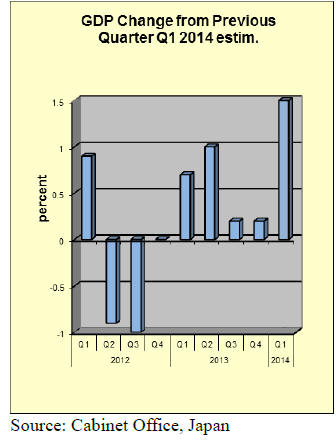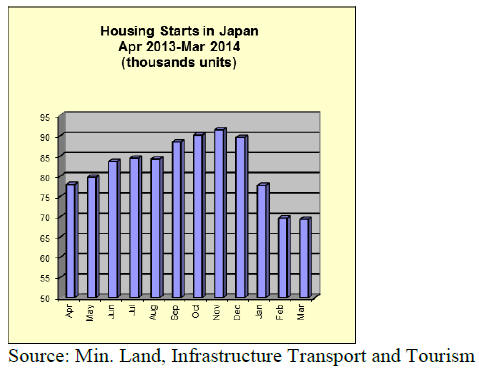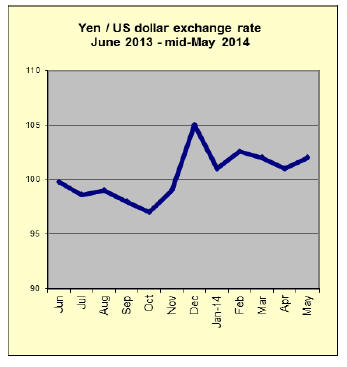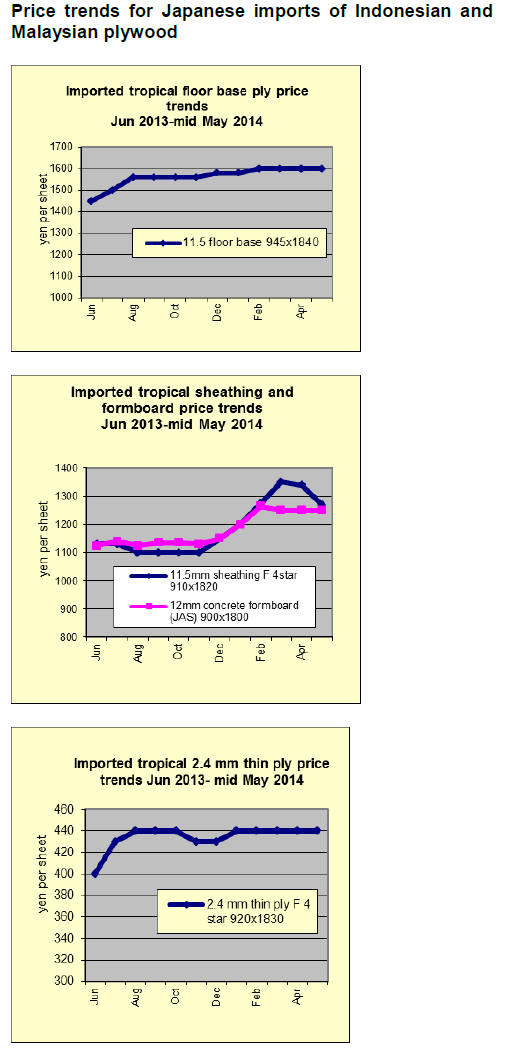Japan Wood Products
Prices
Dollar Exchange Rates of
9th May2014
Japan Yen 101.83
Reports From Japan
GDP ‘rocket’ in first quarter
Japan‟s first quarter GDP was up 1.5 percent from the last
quarter of 2013. This figure is way beyond analysts‟
expectations and reflects the surge in consumer spending
prior to the increase in consumption tax.
Personal consumption was so high in the first quarter that
any impact from the slowing of the US was overwhelmed.
Private consumption in the first quarter was up an
annualised 8.5%!
The boost to GDP growth defies the overall sluggish
economic performance and is a one-off surge unlikely to
be repeated in the quarters to come. Second quarter figures
due in July are expected to be very sobering.

Women in the workforce
The labour crisis in Japan will only get worse as the
country‟s birthrate is falling and is already one of the
lowest in the world. Estimates suggest that the population
(excluding immigration) could fall by close to 50 percent
by 2060. The present government is considering loosening
immigration rules to allow more foreign workers but most
analysts see greater benefits in getting Japanese women
into the workforce.
The huge pool of well-educated women in Japan is a
potential resource to help revive the economy. At present,
mainly due to inadequate child care facilities many women
exit the workforce when they have children and the
corporate structures in Japan offer little incentive for them
to return.
In a recent report by Goldman Sachs (Womenomics) says
“Japan could boost its gross domestic product by 12.5
percent if it closes the gender gap and gets more women
into the workforce”.
See: http://www.goldmansachs.com/ourthinking/
investing-in-women/giving-credit-where-it-isdue.
html
TPP talks progress in Vietnam
Over four days mid-month negotiators from the countries
trying to hammer out a deal for the Trans-Pacific
Partnership met in Ho Chi Minh City. The aim was to
make some progress in time for the ministerial meeting
which will be hosted by Singapore 19 to 20 May.
Japan and the US, representing the two biggest economies
of all 12 members participating in TPP talks made some
progress at a summit between Prime Minister Shinzo Abe
and President Barack Obama last month.
The current round of talks will focus on tariffs, especially
the politically sensitive agricultural grps, intellectual
property and reform of state companies. The news from
the talks was that progress had been made on intellectual
property rights.
However, Koji Tsuruoka, the lead negotiator from Japan,
said agreement on tariff removal is the main stumbling
block.
Mixed signals on prospects in housing market
The combined effect of the week long holidays spanning
the end of April to the first week of May and the increase
in consumption taxwhich has added an extra 3 percent tax
to the price of a house will drive down housing start
figures for April.
There are mixed signals on the prospects for a return to
housing start growth. On the one hand the government and
the Bank of Japan are predicting the slump in starts will be
short lived while on the other hand timber importers,
domestic millers of building components and construction
companies are bracing for a prolonged period of sluggish
growth in housing.

Yen moves in narrow range
In mid-May the yen strengthened slightly against the
dollar rising to yen 101.83 to the dollar as holders of US
dollars reacted negatively to the risks of even tighter US
sanctions on Russia and shifted more resources into yen.

For the JLR report please see:
http://www.nmokuzai.
com/modules/general/index.php?id=7
Price hike by secondary processors of South Sea
(tropical) plywood
Secondary plywood processors to make print plywood and
color plywood are facing higher cost of raw materials so
they are proposing higher prices since April.
Because of price increase of imported South Sea
hardwood plywood mainly due to weaker yen, the
manufacturers increased the sales prices about a year ago
but it was hard to pass higher cost onto sales prices.
Currently the prices of imported thin plywood have been
climbing due to higher log cost, labor cost and energy cost
in producing regions plus weaker yen in Japan. The
manufacturers have to use such high cost materials when
the demand is slowing by consumption tax increase since
April. There is no other way to absorb higher cost but to
price hike.
Meantime, house builders have no room to accept higher
materials cost when new orders are declining. So the
situation is very severe for the manufacturers.
Nankai Plywood (Kagawa prefecture), manufacturer of
wall of closet by print plywood, increased the sales prices
last year but the cost further increased so that it needs to
ask another hike again. Future cost of imported plywood
seems to be strong but demand for the products is slowing.
Another wood floor manufacturer in Aichi prefecture has
been increasing sales prices of composite floor since last
year but it is hard to pass onto higher cost while
manufacturing cost has steadily climbing. It tries to switch
to use domestic raw materials to avoid volatile imported
materials.
Tenryu Lumber (Shizuoka prefecture) announced price
hike of wall, specially made embossed plywood for
furniture and fixtures and others made with imported
plywood base by 15-20% since April 1 because price of
Indonesian thin plywood climbed considerably, which is
the main raw material for the product. Not only raw
material cost but other cost like adhesive, trucking and
crating materials is also up.
Supply and demand of composite floor in 2013
The Japan Laminated Wood Flooring Manufacturers
Association disclosed supply and demand of composite
floor in 2013.
Total production was 20,469,600 tsubo (1 tsubo=3.3
square meters), 9.8% more than 2012 and the shipment
was20,424,100 tsubo, 11.1% more than 2012.
This is five straight years‟ increase over previous year.
Increase of new housing starts in 2013 with rush-in orders
before the consumption tax increase obviously contributed
larger production and shipment.
Sheet floor production was 8,769,800 tsubo, 9.8% more
than2012 and the share in total composite floor was about
43%. It is popular because color is uniform and has least
claim so that there are brisk orders from builders of
condominium and units built for sale. The quality largely
improved such a way that appearance is so close to natural
wood.
By type of base material, share of composite type three,
which base materials are fiber board or composite of
plywood and fiber board was about 55% with 11,291,100
tsubo as compared to type one, which base is plywood
only.
This proves that the manufacturers have been trying to
change base material from unstable supply of imported
South Sea hardwood plywood to fiber board. Also there is
increasing product with domestic softwood plywood as
base board.
The Wood Use Point system helps use of domestic wood
plywood. There are many composite base with softwood
plywood and fiber board.
Wooden trestles for solar panels
As more solar power generation facilities are built, more
demand for trestles to place solar panels is expected to
grow. So far, majority of trestles are either steel or
aluminium. The Japan Wood Preservers Industry
Association has been promoting to develop demand for
wood trestles for solar power generation.
The problem of wooden trestle was higher design and
placement cost but now they are down enough to compete
with metal trestles then for life of wooden trestles, 20
years life is guaranteed by chemical treatment, incising
process and pressurized injection.
Now wooden trestles can be competitive in cost and have
same durability with metal trestles. As to life of 20 years,
by the Forest Agency‟s supplementary business of
durability test of preservative treated wood in 2011, it is
confirmed that domestic cedar, cypress and larch can have
more than 20 years life if they are properly treated with
JAS K4 class chemical.
Also by the Forestry Agency‟s supplementary business for
cost and life of wooden trestles for solar panels in 2013, it
revealed that wooden trestles have enough competitive
factors with metal trestles. Three major wood preservative
treating companies, Xyence, Koshii and Kanematsu KNN
has made model trestles with cedar, which are treated with
K4 to find out actual cost and to verify that wooden
trestles are competitive with metal trestles.
Wood chip market
After FIT system (energy purchase system with fixed
prices generated by renewable resources) started in July
2013, there are many projects of wood biomass power
generation and many plans to start up in 2015 so that
movements to purchase and collect wood resources for
fuel have started in everywhere.
So far, majority of demand of wood chip has been paper
and pulp manufacturing then biomass wood chip for
power generation is totally new demand. Right at this
moment, there is no place where wood chip supply is tight
and the prices soar but locally wood biomass wood chip
prices exceed that for paper manufacturing.
To prepare biomass wood chip demand, there are
movements to collect low grade logs for fuel and to bring
in portable wood chippers into the woods to produce wood
chip for biomass generation.
Demand of wood chip for paper manufacturing has been
recovering after a long time. Since late last year, orders for
printing paper and card board increased before the
consumption tax increase then by weakening yen, import
of papers like copy paper decreases and export of paper
increases, which stimulate paper production in Japan.
Accordingly demand of wood chip for paper
manufacturing increases. Housing starts were active last
year and sawmills were busy for lumber production, which
generated more residue, which helped production of wood
chip. Thus far, there is no panic of wood chip supply and
demand but after many biomass power generation
facilities start up, supply shortage will come for sure.
Importing wood chip from overseas resources is based on
annual contract so that the volume is fixed and any
increment demand of wood chip has to be fulfilled by
domestic supply. The prices of imported wood chips are
climbing. Softwood chip prices from the U.S.A. are 12%
up compared to last October and softwood chip prices
from Australia are 7% up. By weak yen, arrived cost is
higher.

|